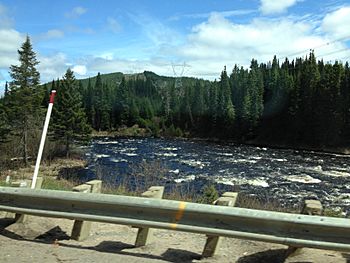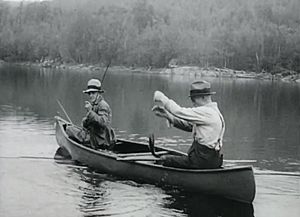Pikauba River facts for kids
Quick facts for kids Pikauba River |
|
|---|---|
 |
|
| Native name | "Grande rivière Pikauba" and "rivière Chicoutimi" |
| Country | Canada |
| Province | Quebec |
| Region | Saguenay-Lac-Saint-Jean |
| Regional County Municipality | Le Fjord-du-Saguenay Regional County Municipality |
| Unorganized territory and a city | Lac-Pikauba and Saguenay |
| Physical characteristics | |
| Main source | Pikauba Lake Lac-Pikauba 867 units? 47°47′58″N 71°08′45″W / 47.7995°N 71.1459°W |
| River mouth | Kenogami Lake Saguenay 164 m (538 ft) 48°19′30″N 71°26′28″W / 48.325°N 71.441°W |
| Length | 138.8 km (86.2 mi) |
| Basin features | |
| Tributaries |
|
The Pikauba River is a beautiful river in Quebec, Canada. It flows into Kenogami Lake. This river runs through two main areas: Lac-Pikauba and Lac-Ministuk.
The Pikauba River is special because it flows through the Laurentides Wildlife Reserve. This area is known for its amazing nature. You can reach the river valley by using Route 169 and Route 175, which connect Quebec City and Chicoutimi. There are also smaller forest roads for exploring and outdoor fun.
For a long time, the Pikauba River and Pikauba Lake have been famous for fishing and hunting. In the past, there were lots of trout, and caribou hunting was very popular. The river usually freezes over from late November to early April. It's generally safe to walk on the ice from mid-December to late March.
River Journey: Where Pikauba Flows
The Pikauba River is one of the most important rivers between Quebec City and Saguenay. It flows through a narrow path surrounded by steep mountains. Along its way, you'll find many rapids and waterfalls. As it gets closer to its end, the river widens, getting more water from other rivers like the Apica, Écorces, Pika, and Petite Pikauba. Finally, it empties into the western part of Kenogami Lake.
River's Beginning: Pikauba Lake
The Pikauba River starts at the southeast end of Pikauba Lake. This lake is also the source of another river, the Cyriac River. Pikauba Lake is located in the middle of the Laurentides Wildlife Reserve. It's about 10.2 kilometers (6.3 miles) long and 1.9 kilometers (1.2 miles) wide. The lake is quite high up, at 827 meters (2,713 feet) above sea level.
From Pikauba Lake, the Pikauba River travels about 138.8 kilometers (86.2 miles). During its journey, it drops about 677 meters (2,221 feet) in height.
The River's Path: From Source to Mouth
The Pikauba River's journey can be divided into different parts:
Upper River Course
The first part of the river flows for about 37.6 kilometers (23.4 miles). It starts by heading southwest, then turns southeast, following Route 175. It passes under a bridge and then turns northwest, flowing through a deep valley.
Middle River Course: First Section
This section is about 39.6 kilometers (24.6 miles) long. The river flows northwest, then north, passing by Davenport Lake. It then winds its way westward and northwest, often running alongside Route 169.
Middle River Course: Second Section
This part of the river stretches for about 35.1 kilometers (21.8 miles). It continues northwest through a deep valley, making a small turn to the east. It then winds northwest again, meeting the Pika River and the Petite Pikauba River.
Lower River Course
The final part of the Pikauba River is about 26.5 kilometers (16.5 miles) long. It flows north, picking up water from smaller streams. It then turns northwest, meeting the Rivière aux Écorces and ruisseau L'Abbé. Finally, it makes a few turns northeast and northwest before reaching its mouth.
Where the River Ends: Kenogami Lake
The Pikauba River flows into a bay on the south side of Kenogami Lake. From this point, the water travels about 17.6 kilometers (10.9 miles) northeast through Kenogami Lake to the Portage-des-Roches dam. After that, it joins the Chicoutimi River for 26.2 kilometers (16.3 miles) and then the mighty Saguenay River for 114.6 kilometers (71.2 miles) eastward. The Saguenay River eventually flows into the Saint Lawrence Estuary at Tadoussac.
What's in a Name? The Story of Pikauba
The name "Pikauba" is used for two rivers and a lake in the Laurentian wildlife reserve. An old map from 1731 called this river "Ouapikoupau river."
According to some experts, the name "Pikauba" comes from the Innu and Cree languages. One idea is that it means "tightened or masked by rushes," referring to plants that grow in the water. Another idea is that "pikobaw" can be broken down into "pik" (meaning "small" or "menu"), "kobaw" (meaning "scrub"), and "wabi" (meaning "white"). This would mean "white brush" or "small brush."
In 1981, the Commission de toponymie du Québec (Quebec's place names commission) officially changed how this river was named. Before that, maps from 1900 to 1930 called it "Grande Rivière Pikauba" (Great Pikauba River) and Petite Rivière Pikauba (Little Pikauba River). In 1940, the names "Chicoutimi" and "Pikauba" officially replaced them. Today, the part of the river south of Kenogami Lake is known as the "Pikauba River," and its smaller branch is called the "Petite rivière Pikauba."
The name "Pikauba river" was officially recognized on January 8, 1981.
Related Articles
- Charlevoix Regional County Municipality
- Le Fjord-du-Saguenay Regional County Municipality
- Lac-Pikauba, an unorganized territory (TNO)
- Lac-Ministuk, an unorganized territory (TNO)
- Saguenay River, a stream
- Chicoutimi River, a stream
- Pikauba Lake, a body of water
- Kenogami Lake, a body of water
- Rivière aux Écorces, a watercourse
- Pika River, a stream
- Apica River, a stream
- Little Pikauba River, a stream
- List of rivers of Quebec


